
Orchids are plants that belong to the family Orchidaceae, a diverse and widespread group of flowering plants with blooms that are often colourful and fragrant. Orchids are cosmopolitan plants that are found in almost every habitat on Earth except glaciers. The world's richest diversity of orchid genera and species is found in the tropics.
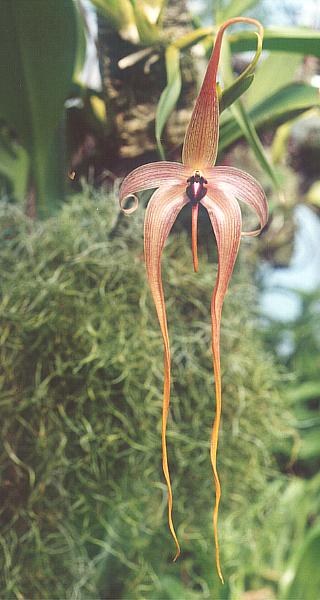
Bulbophyllum is a genus of mostly epiphytic and lithophytic orchids in the family Orchidaceae. It is the largest genus in the orchid family and one of the largest genera of flowering plants with more than 2,000 species, exceeded in number only by Astragalus. These orchids are found in diverse habitats throughout most of the warmer parts of the world including Africa, southern Asia, Latin America, the West Indies, and various islands in the Indian and Pacific Oceans. Orchids in this genus have thread-like or fibrous roots that creep over the surface of trees or rocks or hang from branches. The stem is divided into a rhizome and a pseudobulb, a feature that distinguished this genus from Dendrobium. There is usually only a single leaf at the top of the pseudobulb and from one to many flowers are arranged along an unbranched flowering stem that arises from the base of the pseudobulb. Several attempts have been made to separate Bulbophyllum into smaller genera, but most have not been accepted by the World Checklist of Selected Plant Families.
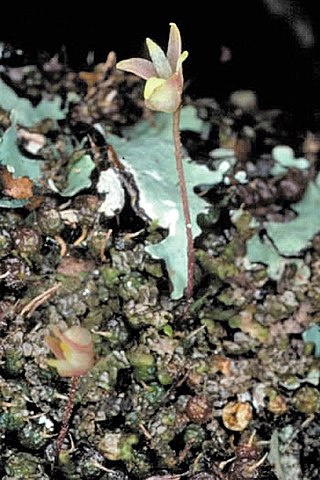
Bulbophyllum globuliforme, commonly known as the green bead orchid, miniature moss-orchid or hoop pine orchid, is a species of epiphytic orchid with tiny spherical pseudobulbs, scale-like leaves and small cream-coloured flowers with a yellow labellum. It grows on the scaly bark of hoop pine, mostly on the McPherson Range on the New South Wales/Queensland border in eastern Australia. Because of its small size it is often dismissed as moss.

Bulbophyllum fletcherianum, the tongue orchid, Fletcher's bulbophyllum or Spies' bulbophyllum, is a rare orchid native to southern New Guinea. It prefers sunny rock outcrops or mossy tree branches, but besides being lithophytic or epiphytic, it can also be pseudo-terrestrial. The tongue orchid requires high humidity and moist roots.
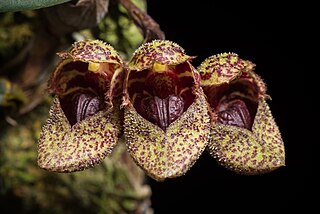
Bulbophyllum frostii, commonly known as Frost's bulbophyllum or Dutchman's shoes is a species of orchid, In the wild it grows as an epiphyte, inhabiting evergreen seasonal lowland rainforests in Vietnam and more rarely in Thailand, including the Malay peninsula. It was more recently reported growing in the Yunnan province of China during a series of botanical surveys between 2017 and 2020. This plant is usually found at elevations of around 1500m above sea level.
Bulbophyllum abbrevilabium, also known as the short-lipped bulbophyllum, is a warm-growing species of orchid in the genus Bulbophyllum. It is found in the Southeast Asian countries Thailand, Malaysia and Vietnam. It bears a flower about eight millimetres wide. Akin to the majority of orchid species, it is a pseudobulb epiphyte, and is typically found hanging from tree branches.

Bulbophyllum arfakianum is a species of orchid in the genus Bulbophyllum. This rare orchid is endemic to Arfak Mountains at elevations 50~400 meters in rainforests, Papua New Guinea.

Bulbophyllum baileyi, commonly known as the fruit fly orchid, is a species of epiphytic or lithophytic orchid that is native to Queensland and New Guinea. It has coarse, creeping rhizomes, curved, yellowish pseudobulbs with a single thick, fleshy leaf, and a single cream-coloured flower with yellow, red or purple spots. It grows on trees and rocks in open forest, often in exposed places.
Bulbophyllum chimaera is a species of orchid in the genus Bulbophyllum.
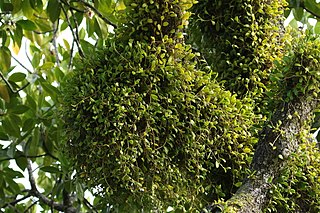
Bulbophyllum clandestinum is a species of orchid in the genus Bulbophyllum. This orchid grows long hanging rhizomes from which it produces tiny pseudobulbs that each bear one leaf. Flowers are born on each node, they are 3–5 cm in length and are a creamy colour. It is native to Borneo, Laos, Malaysia, Myanmar, Thailand, the Philippines, and Vietnam.
Bulbophyllum eublepharum is a species of orchid in the genus Bulbophyllum. Chromosome count is 2n = 38. Plants are epiphytes.

Bulbophyllum exiguum, commonly known as the tiny strand orchid, is a species of epiphytic or lithophytic orchid that is endemic to eastern Australia. It has small, roughly spherical pseudobulbs each with a single leaf and up to three small creamy white to yellow flowers emerging from the base of the pseudobulb. This orchid grows in rainforest and dry forest where it often covers the branches of trees or rocks on which it grows.

Bulbophyllum grandimesense, commonly known as the pale rope orchid, is a species of epiphytic orchid with well-spaced pseudobulbs and brown bracts arranged along the stems. Each pseudobulb has a single, fleshy, dark green leaf and usually only a single white flower with thread-like tips on the sepals. It grows on rainforest trees in a small area of tropical North Queensland.
Bulbophyllum reichenbachii is a species of orchid in the genus Bulbophyllum, found in northern Burma. The orchid grows on the trunks of trees, forming clumps.
Bulbophyllum samoanum, also known as the Samoan bulbophyllum, is a species of orchid in the genus Bulbophyllum.
Bulbophyllum weberi is a species of orchid in the genus Bulbophyllum.
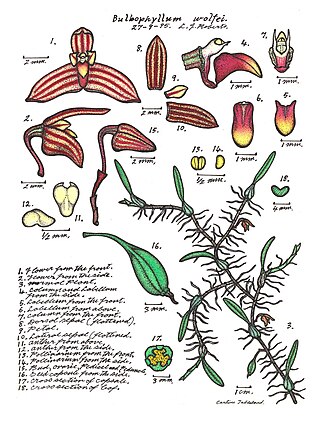
Bulbophyllum wolfei, commonly known as the fleshy snake orchid, is a species of epiphytic or lithophytic orchid with thin, creeping rhizomes, and flattened pseudobulbs each with a single thick, fleshy, dark green leaf and a single cream-coloured flower with dark red stripes. It mostly grows on rainforest trees in tropical North Queensland.
Bulbophyllum crabro, commonly called "Kam Pu Ma" in Thai, is a small orchid that grows as an epiphyte or is sometimes found as lithophyte. It grows in rainforests 1,600-2,000 m above sea level. It was formerly known as Monomeria barbata and was the type species of the genus Monomeria, now synonymous with Bulbophyllum. It is used in traditional Chinese medicine for treating coughs, pulmonary tuberculosis and trauma.
Bulbophyllum nocturnum is a species of epiphytic orchid that grows in New Britain. It was described in 2011, and is the first species of orchid known to consistently flower during the night, and close its flowers during the day.

Bulbophyllum ericssonii is a species of orchid in the genus Bulbophyllum that grows from Malesia to New Guinea.











